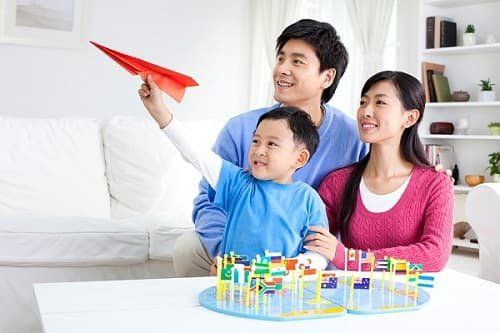This is an automatically translated article.
Article by Master Nguyen Thi Yen - Pediatric Speech Therapist - Vinmec Time City International Hospital
Maria Montessori - the founder of the Montessori method of education once said: "Play is the work of children". So who will be the fathers and mothers in the process of children doing their jobs. The father is the supervisor, the mother is the examiner or the father is the guide, the mother is the companion,... How you become in your child's game will determine the quality of the child's "work". Because playing is the work of children, however, children will not be able to complete the game and develop their learning skills if they play alone.
1. Parents who lead, control or support children
Lead - support - control are different concepts that represent different roles adults play when playing with children. The role of adults will also determine the benefits that children receive in the game. If you are the leader, you will always tend to direct the child's play, for example: the car needs to go up the bridge, then to the gas station, then to the gas pump and then to the supermarket; Young children will be completely passive and dependent on your "instructions". If you want to control your child's play by preventing him from touching the clay because he's afraid he's dirty, asking him to only play indoors but not going out for fear of being unsafe,...very likely. , children will become timid and do not dare to explore any new activities or wait for your permission to do an activity.
When adults control, lead or support more than necessary, we have been violating an important principle of play that is "Following the child's lead" - letting children choose their own games enjoy and play the game the way the child wants. When children lose their freedom to explore and play the way they want, their play experiences lose the meaning of “Real Play”.
On the contrary, if you are the one who supports your child's play, provides toys and all other supports when needed, and participates in his child's play activities voluntarily and joyfully, you will become "a part of your child's life." ” in my game. Therefore, for parents to have fun with their children, they also need to have their own strategies.
2. Plan and prepare for play with your child
Adults have the ability to control the environment around children including: arranging rooms, utensils, toys, ... By creating a happy and safe environment to play with children can help children develop comprehensive skills such as: problem-solving skills, thinking, language, social skills,... You can plan for the following jobs:2.1 Arrange a safe and secure environment structure When you structure your child's play environment (both indoor and outdoor) based on a child's strengths, interests, abilities, and needs, you can encourage independent play and have fun. For example:
Create signs to identify places of play such as: playing on the carpet, playing in a tent,... Design a dedicated space for different activities: active play area, reading area ,... Arrange items to ensure safety for children when playing. For example, there are carpets in the active play area,...

Cha mẹ nên vui chơi cùng con theo kế hoạch
2.2 Provide learning opportunities through the setting of the learning environment You can arrange the environment to challenge the child's current knowledge and skills. For example: in the stadium, you leave a small stool near the ball house. Children love to play ball but cannot climb into the ball house by themselves. In the room, you put the toys in inner boxes with lids and put them in a high position. Children can see but cannot reach toys on their own. These situations force children to think through problem solving in order to get the toy they want. Or parents can create games with their children to see how the child will react.
2.3 Give your child options You can give your child a few toys to choose from and decide what he or she will play with. Providing options helps children learn to make decisions independently. In addition, you will know more about the interests, needs, and playing capacity of children, from which there will be arrangements and preparation for future activities.
3. Parents support to play with their children
To help your child learn, play and develop, in addition to providing a safe, fun environment for your child, you also need to take the time to observe and learn to understand your child. Only when you understand your child can you give them the support they need when they need it, without making them dependent on you. You can use some strategies when playing with children such as:
3.1 Talk about children's play Adults can talk about what children are doing and provide support when children need it during play. When adults describe what children are doing without violently interfering with their play, children learn that adults care about them and respect the way they play. Aggressive interventions in a child's play include: taking toys or turns without the child's consent, preventing or disallowing a child from performing play the way he or she wants (except for actions that may cause dangerous or unsafe for children). To talk about children's play, adults can use self-talk (talk about what you're doing when your child is looking at you) and parallel talk (talk about what children are doing with their toys). .
3.2 Acknowledge the child's efforts The child may not speak well or play the toy properly. But these things are really not as important as the child's effort to learn and connect and communicate with people, especially his playmates. So acknowledge it by praising and naming the efforts your child is making to play and communicate with you. Give specific praise, for example: “oh, you looked at me”; “Great, I'm trying really hard to open this toy”,... Your closeness and respect will bring many positive experiences and encourage children to communicate more and be more confident.
3.3 Add activities to children's games When engaging with children in a fun way, adults can help develop a child's knowledge and skills to a higher level by adding a new toy or add a comment,... Example:
Use a variety of words to describe what's going on, provide and model for children how to use a new word or sentence, as a conclusion Combine words together to form a variety of sentences. Add toys to the activity your child is playing, or play in a different way (compared to the way the child is playing), playing a little harder than the child's current level of play. Model appropriate behaviors and interactions.

Vui chơi cùng con với những hoạt động phù hợp
3.4 Create opportunities and encourage play To teach your child the skill of brushing teeth, every day, you have about 2-3 opportunities to teach your child. With play, however, you can create 2 or 20 opportunities for your child to practice a particular skill. The number of practice opportunities will depend on the child's interests, interests, and motivation to play. Creating opportunities and encouraging children to play will help children learn new skills, practice the skills they have learned, and learn to generalize and have real-world experience of practicing a skill. in everyday life. To create one or more opportunities for children to learn depends on the delicate observation and meticulous preparation of the parents - the child's big playmates. Therefore, to best support the development of children's play skills, you should cleverly create as many learning opportunities and encourage them to do it. To make sure your child participates in most learning opportunities, start with the things they are capable of and the things they enjoy.
3.5 Keep Play Fun A fun play activity not only promotes interaction but also helps children develop language, communication, thinking, and problem-solving skills. Therefore, always make sure that playing with your child is fun and enjoyable. If your child seems bored or wants to switch activities, don't worry, just stick with him and wait for the right opportunity to guide him back to play.
3.6 Preventing Unexpected Problems Unexpected problems can include: conflicts that occur between the child and others; the loss/damage of a toy makes the child feel uncomfortable, unsafe situations, etc. By actively participating in the child's play, adults can assist in handling the situation. Unexpected situations arise and make the child feel calmer. The support and prevention does not mean that the adults do the work for the children. The important role of problem situations is that children will have the opportunity to learn and deal with them on their own based on the knowledge and skills they already have. Make sure you're patient enough to give your child a chance to figure things out on their own before you intervene (except in cases where it's really unsafe and dangerous to the child). You may need to tell your child in advance about possible situations when playing and how to behave appropriately to prevent unexpected behaviors such as: fussing, tantrums,...
3.7 Back When you become a close playmate, you will easily connect your child with other people, for example: peers, classmates, neighbors, cousins children,... Developing social relationships will help children become more confident and learn many social skills from playing programs with them.
4. Revisiting children's play
Acknowledging and giving meaningful feedback about your child's play helps you gather information about your child's: interests, play style, which can help expand your child's play behaviors and skills. Giving meaningful feedback to play and communication (both verbal and nonverbal) helps children understand that what they say has meaning and has a communicative function. To respond to your child's play, you need to pay attention to:4.1 Observe your child's play By observing your child's play, talking, and listening to your child, you can gain an understanding of goals, effectiveness, and enjoyment. children while playing. That information will help you design activities that are practical, fun, and meaningful for children in the future.

Vui chơi cùng con kết hợp quan sát việc chơi của con
4.2 Looking back at the arrangement of the play space A safe, appropriate play space is extremely important to children. Arrangements in the environment that are likely to help children interact more (for example, you put toys they like in the box, children see but can't open them, they will ask you to help) or demonstrate thinking skills, solve their own problems (e.g. the child picks up a chair for a toy that the mother keeps in a high place). Therefore, in addition to providing toys and support when needed, think about arranging play environments that can encourage and create the most opportunities for children to demonstrate their knowledge and skills. me. However, it should not be too difficult compared to the child's ability, because if there are too many challenges, the child will feel depressed and lose confidence because of constantly failing. After each play session, try to jot down a few things you think need to change or rearrange your child's play environment.
4.3 Plan Play While you're playing with your child, get serious about learning about your child's interests, hobbies, and progress. That way, you'll gather a lot of information and start planning future play, based on your child's needs and interests. The goals of the new play plans will include providing learning opportunities to enhance children's experiences and skills as well as to inspire play and develop a child's drive to explore.
Please dial HOTLINE for more information or register for an appointment HERE. Download MyVinmec app to make appointments faster and to manage your bookings easily.
Reference source: canr.msu.edu












